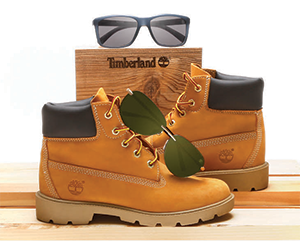
Young and contemporary, Guess and Diesel sunglass styles reflect the brand’s core values.
Companies with world-class service have long understood the central importance of a positive customer experience in building brand equity. Disney “cast members” (employees) are taught that their job, first and foremost, is to create magical moments. Nordstrom built a famed culture of service in which store clerks go the extra mile to personalize the customer experience and “make the customer happy.” Nordstrom customers value the store’s selectivity of premier brands and its personalized in-store service. The latter is augmented by an online “live chat” option where a service specialist assists shoppers in finding items and collections that best suit their needs.
In short, great service-oriented companies succeed by exceeding expectations. Delivering exceptional service is part of their brand.

The Timberland eyewear collection is designed and marketed by Marcolin to urban millennials who enjoy adventure and are living life on the “Modern Trail”.

When it comes to in-store merchandising, tying the eyewear back to iconic brand elements is a great way to appeal to millennials.
But in today’s crowded marketplace, matching consumer demand with the right product mix can be tricky. Consider this: Sixty-five percent of Americans over the age of 18 wear prescription eyeglasses. When these customers walk into an eyecare practice or an optical shop, they are carrying armfuls of preconceived ideas about brands and styles and yes, even colors.
The key to getting it right is deciphering what will motivate consumers to make the buy — is it price, a designer name, a trending color, a certain look, or all of these factors?
Putting the right brands and the right frames on the board is contingent on two key points: Understanding customer demographics, and fostering strategic partnerships to build the right assortment. This unique formula will go a long way toward boosting sales and building customer loyalty for independent eyecare professionals.
The Demographic Footprint. Age and income are important, but the customer’s education, marital status, occupation, hobbies and interests also need to be considered. To fully appreciate what customers need, it is relevant to pay attention to what they do. Do they play sports? Is driving a part of their lifestyle? Are they fashion- conscious? Or do they just balk at swapping out their old frames for a new look?
Curating this information and using it to create a diversified product mix can be a challenge. Trying to be everything to everyone can only end in disappointment. Getting it right means finding the balance between frames that are on the cutting edge of what’s new and those that are proven bestsellers.
Hand-in-Hand Partnerships. Fostering strategic partnerships with companies that offer a diversified brand portfolio, such as Marcolin, can simplify inventory management and make that balance easier to attain. Taking that partnership a step further, eyecare professionals who maintain strong relationships with knowledgeable sales reps gain valuable insights on board and assortment planning, all of which is key to ensuring the product mix stays on point and sell-through is strong.
For example, with over 50 years of excellence in the eyewear industry, Marcolin with its sales force can help determine the ideal ratio of best sellers to new, unproven styles and can assist in phasing in new brands. There’s a reason why most frame boards lean heavily on black and tortoise; they are timeless, tried-and-true sellers. Eyewear has become a fashion statement, a part of everyone’s wardrobe that adds a special touch to each look. An intuitive sales rep who has a strong handle on customer demand can demonstrate how targeted pops of color and unexpected style choices can lead to increased profits. Additionally, a competent sales rep can help train and educate optical staff, troubleshoot problems, and anticipate a practice’s evolving needs.
By focusing on key demographic markers and nurturing partnerships across the board, eyecare professionals will not only benefit from a product mix that exceeds expectations but also from the ongoing loyalty of highly satisfied customers. ■
CURATING A COLLECTION
To fashion a diversified collection, every ECP should ask — and answer — these basic questions:
- Who is your customer? Go beyond age and income. Show a genuine interest in patients and quickly garner loyalty and an edge over the competition.
- What do they do? The answers to where they work, how they spend their free time, and what motivates them to try something new are the clues needed to stock the boards with the right presentation.
- Where are you located? Some Marcolin brands, like Guess and Timberland, with their social media presence and progressive agenda, are a natural fit for independent ECPs catering to millennials. Others, like Zegna and Tod’s, speak to a more upscale, high-end clientele in an urban environment.
- How can you foster growth? Partnerships are key. Marcolin sales representatives provide brand trainings for office staff at no additional cost. These trainings help give ECPs and their sales associates the tools and talking points needed to steer customers toward a satisfied purchase and repeat sales down the line. ■











